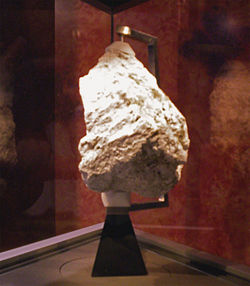Feldspar

Feldspar is the name of a group of rock-forming minerals that make up as much as 60 percent of the Earth's crust. Feldspars crystallize from magma in both intrusive and extrusive rocks, and they can also occur as compact minerals, as veins, and are also present in many types of metamorphic rock. Rock formed entirely of plagioclase feldspar (see below) is known as anorthosite. Feldspars are also found in many types of sedimentary rock.
Etymology
Feldspar is derived from the German Feld, field, and Spat, a rock that does not contain ore. "Feldspathic" refers to materials that contain feldspar. The alternative spelling, felspar, has now largely fallen out of use.
Composition
This group of minerals consists of framework or tectosilicates. The compositions of common feldspars can be expressed in terms of three endmembers:
- K-feldspar endmember
- Albite endmember
- Anorthite endmember
Solid solutions between K-feldspar and albite are called alkali feldspar. Solid solutions between albite and anorthite are called plagioclase. Only limited solid solution occurs between K-feldspar and anorthite, and in the two other solid solutions, immiscibility occurs at temperatures common in the crust of the earth.
Sanidine (monoclinic), orthoclase, and microcline (triclinic) refer to polymorphs of K-feldspar. Sanidine is stable at the highest temperatures, and microcline at the lowest. Perthite is a typical texture in alkali feldspar, due to exsolution of contrasting alkali feldspar compositions during cooling of an intermediate composition. The perthitic textures in the alkali feldspars of many granites are coarse enough to be visible to the naked eye.
Compositions of the plagioclase series have been labeled as follows (percent anorthite in parentheses):
- albite (0 to 10)
- oligoclase (10 to 30)
- andesine (30 to 50)
- labradorite (50 to 70)
- bytownite (70 to 90)
- anorthite (90 to 100)
Intermediate compositions of plagioclase feldspar also may exsolve to two feldspars of contrasting composition during cooling, but diffusion is much slower than in alkali feldspar, and the resulting two-feldspar intergrowths typically are too fine-grained to be visible with optical microscopes. The immiscibility gaps in the plagioclase solid solution are complex compared to the gap in the alkali feldspars. The play of colors visible in some feldspar of labradorite composition is due to very fine-grained exsolution lamellae (see image).
Uses
- Feldspar is a common raw material in the production of ceramics.
- Members of this group are used for thermoluminescence dating and optical dating in the earth sciences and archeology.
- Feldspar is an ingredient in Bon Ami brand household cleaner.
See also
ReferencesISBN links support NWE through referral fees
- Deer, W.A., R.A. Howie, and J. Zussman. 1996. An Introduction to the Rock-Forming Minerals. 2nd ed. Upper Saddle River, NJ: Prentice Hall. ISBN 0582300940.
- Farndon, John. 2006. The Practical Encyclopedia of Rocks & Minerals: How to Find, Identify, Collect and Maintain the World's best Specimens, with over 1000 Photographs and Artworks. London: Lorenz Books. ISBN 0754815412.
- Klein, Cornelis, and Barbara Dutrow. 2007. Manual of Mineral Science. 23rd ed. New York: John Wiley. ISBN 978-0471721574.
- Pellant, Chris. 2002. Rocks and Minerals. Smithsonian Handbooks. New York: Dorling Kindersley. ISBN 0789491060.
- Shaffer, Paul R., Herbert S. Zim, and Raymond Perlman. 2001. Rocks, Gems and Minerals. Rev. ed. New York: St. Martin's Press. ISBN 1582381321.
External links
- The Feldspar Group. Amethyst Galleries. Retrieved May 8, 2007.
- Feldspar Group. Mindat.org. Retrieved May 8, 2007.
Credits
New World Encyclopedia writers and editors rewrote and completed the Wikipedia article in accordance with New World Encyclopedia standards. This article abides by terms of the Creative Commons CC-by-sa 3.0 License (CC-by-sa), which may be used and disseminated with proper attribution. Credit is due under the terms of this license that can reference both the New World Encyclopedia contributors and the selfless volunteer contributors of the Wikimedia Foundation. To cite this article click here for a list of acceptable citing formats.The history of earlier contributions by wikipedians is accessible to researchers here:
The history of this article since it was imported to New World Encyclopedia:
Note: Some restrictions may apply to use of individual images which are separately licensed.